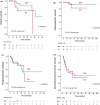Comparison of oncologic and functional outcomes between radical nephroureterectomy and segmental ureterectomy for upper urinary tract urothelial carcinoma
- PMID: 33837237
- PMCID: PMC8035162
- DOI: 10.1038/s41598-021-87573-5
Comparison of oncologic and functional outcomes between radical nephroureterectomy and segmental ureterectomy for upper urinary tract urothelial carcinoma
Abstract
This study aims to compare oncologic and functional outcomes after radical nephroureterectomy (RNU) and segmental ureterectomy (SU) in patients with upper urinary tract urothelial carcinoma (UTUC). We retrospectively collected data on patients who underwent either RNU or SU of UTUC. Propensity score matching was performed among 394 cases to yield a final cohort of 40 RNU and 40 SU cases. Kaplan-Meier analysis and the log-rank test were used to compare overall survival (OS), cancer-specific survival (CSS), progression-free survival (PFS), and intravesical recurrence-free survival (IVRFS) between the groups. We also compared the change in postoperative estimated glomerular filtration rate (eGFR). There was no significant difference in terms of CSS, PFS, and IVRFS between the RNU and SU groups, but the RNU group had a better OS than the SU group (p = 0.032). Postoperative eGFR was better preserved in the SU group than in the RNU group (p < 0.001). SU provides comparable CSS, PFS, and IVRFS for patients with UTUC compared to RNU, even in patients with advanced-stage and/or high-grade cancer. Further, SU achieves better preservation of renal function.
Conflict of interest statement
The authors declare no competing interests.
Figures

Similar articles
-
Oncologic and renal function outcomes of segmental ureterectomy vs. radical nephroureterectomy in upper tract urothelial carcinoma: A systematic review and meta-analysis.Urol Oncol. 2025 Sep;43(9):498-510. doi: 10.1016/j.urolonc.2025.05.011. Epub 2025 Jun 12. Urol Oncol. 2025. PMID: 40514292 Review.
-
A systematic review and meta-analysis of oncological and renal function outcomes obtained after segmental ureterectomy versus radical nephroureterectomy for upper tract urothelial carcinoma.Eur J Surg Oncol. 2016 Nov;42(11):1625-1635. doi: 10.1016/j.ejso.2016.08.008. Epub 2016 Aug 25. Eur J Surg Oncol. 2016. PMID: 27612412 Free PMC article.
-
Robotic radical nephroureterectomy and segmental ureterectomy for upper tract urothelial carcinoma: a multi-institutional experience.World J Urol. 2019 Nov;37(11):2303-2311. doi: 10.1007/s00345-019-02790-y. Epub 2019 May 6. World J Urol. 2019. PMID: 31062121
-
Comparison of oncological outcomes after segmental ureterectomy or radical nephroureterectomy in urothelial carcinomas of the upper urinary tract: results from a large French multicentre study.BJU Int. 2012 Oct;110(8):1134-41. doi: 10.1111/j.1464-410X.2012.10960.x. Epub 2012 Mar 6. BJU Int. 2012. PMID: 22394612
-
Segmental ureterectomy vs. radical nephroureterectomy for ureteral carcinoma in patients with a preoperative glomerular filtration rate less than 90 ml/min/1.73 m2: A multicenter study.Urol Oncol. 2020 Jun;38(6):601.e11-601.e16. doi: 10.1016/j.urolonc.2020.03.005. Epub 2020 Apr 6. Urol Oncol. 2020. PMID: 32273050
Cited by
-
Efficacy of combined organ-sparing management of invasive upper urinary tract urothelial carcinoma.Cent European J Urol. 2023;76(2):162-166. doi: 10.5173/ceju.2023.019. Epub 2023 May 5. Cent European J Urol. 2023. PMID: 37483858 Free PMC article.
-
Kidney sparing surgery versus radical nephroureterectomy in upper tract urothelial carcinoma: a meta-analysis and systematic review.Front Oncol. 2025 Apr 2;15:1448079. doi: 10.3389/fonc.2025.1448079. eCollection 2025. Front Oncol. 2025. PMID: 40242251 Free PMC article.
-
Nephron-Sparing Approaches in Upper Tract Urothelial Carcinoma: Current and Future Strategies.Biomedicines. 2022 Sep 8;10(9):2223. doi: 10.3390/biomedicines10092223. Biomedicines. 2022. PMID: 36140325 Free PMC article. Review.
-
Nephron-sparing management of upper tract urothelial carcinoma.Investig Clin Urol. 2021 Jul;62(4):389-398. doi: 10.4111/icu.20210113. Investig Clin Urol. 2021. PMID: 34190434 Free PMC article. Review.
-
Analysis of progression after elective distal ureterectomy and effects of salvage radical nephroureterectomy in patients with distal ureteral urothelial carcinoma.Sci Rep. 2024 Feb 12;14(1):3497. doi: 10.1038/s41598-024-54232-4. Sci Rep. 2024. PMID: 38347103 Free PMC article.
References
Publication types
MeSH terms
LinkOut - more resources
Full Text Sources
Other Literature Sources
Medical
Research Materials
Miscellaneous

